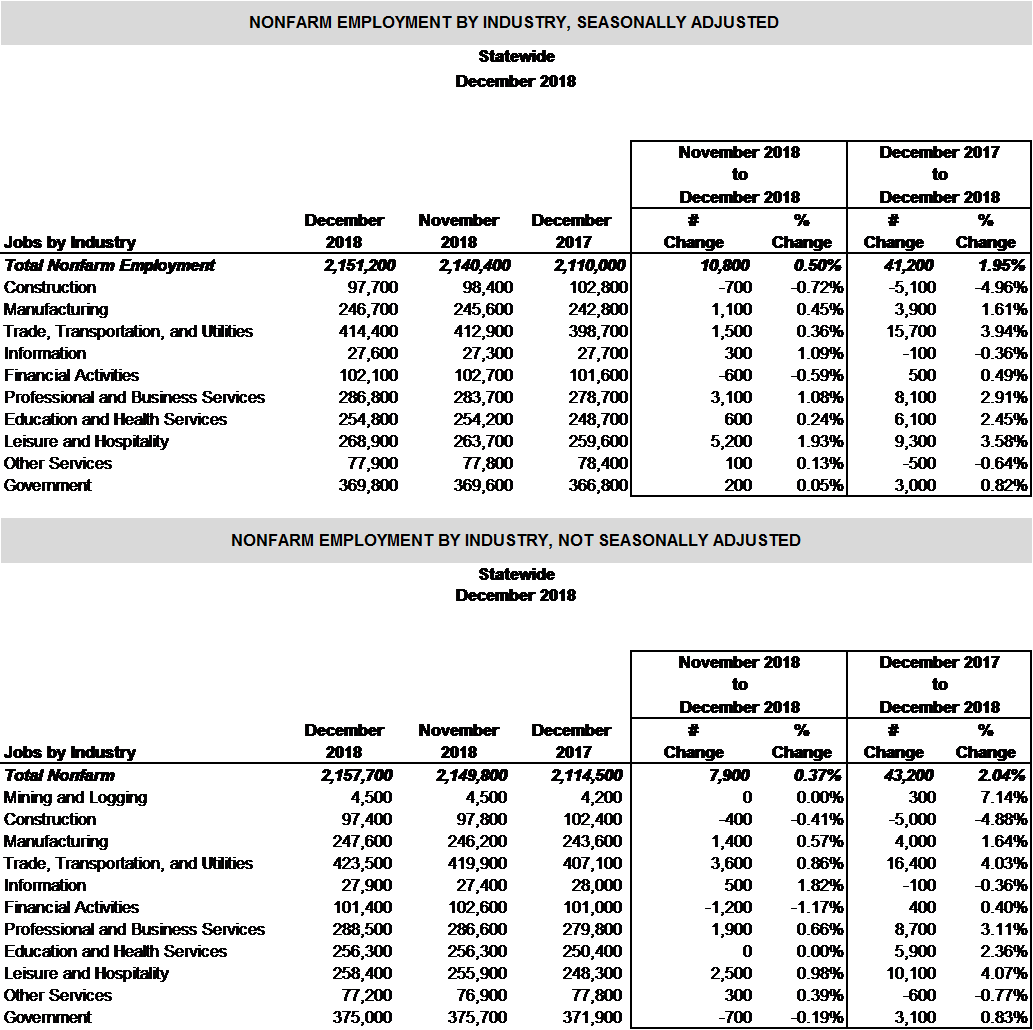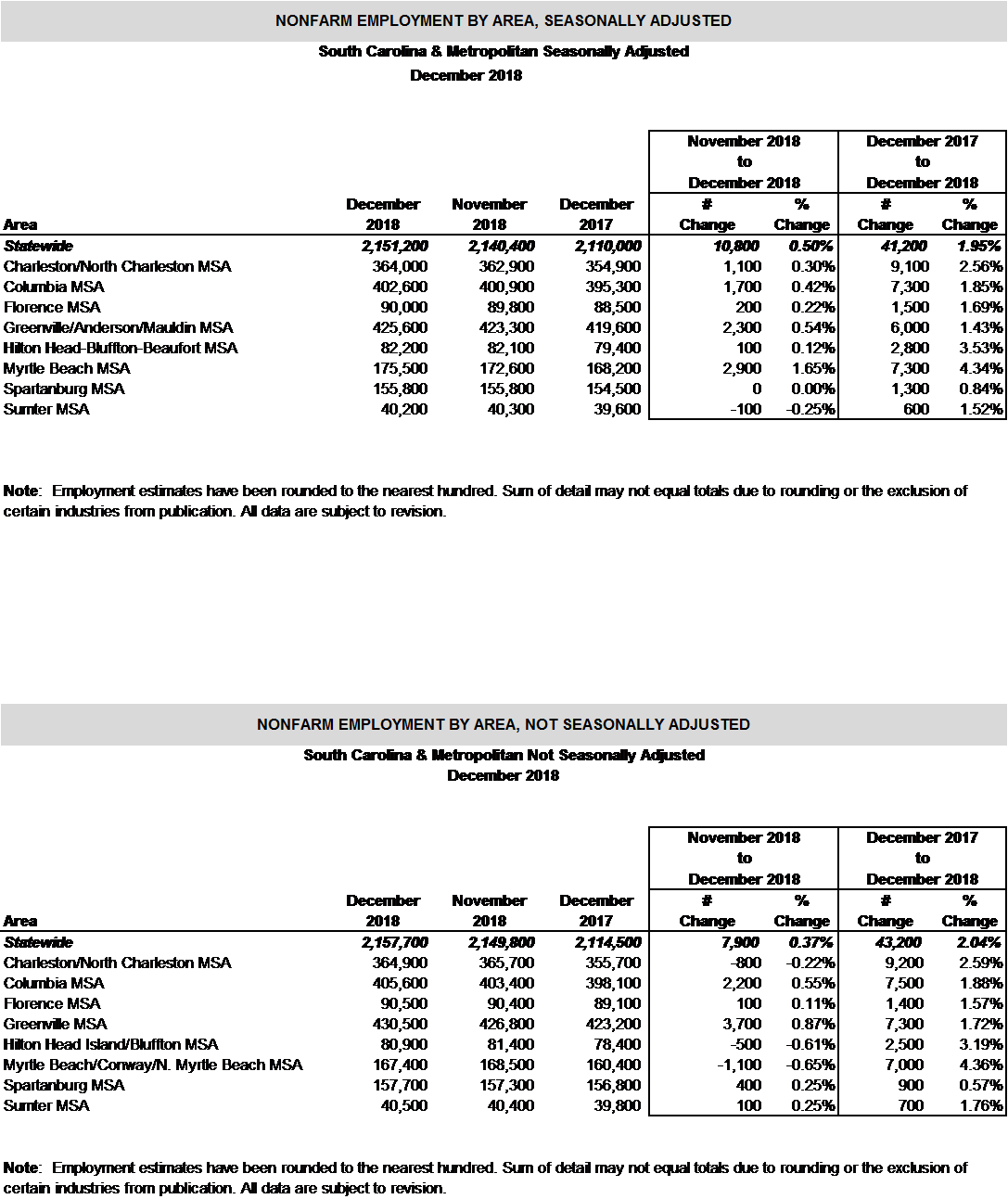MyBenefits
Apply for and certify your claim here.
 The Official Web Site of the State of South Carolina
The Official Web Site of the State of South Carolina
South Carolina’s Employment Situation
December 2018
Robust Job Growth Continues,
Unemployment Rate Unchanged
The number of individuals working across the state increased substantially, by an estimated 7,142 people, marking a new record level of 2,242,540 for the Palmetto State.
Unemployment estimates showed little change over the month, increasing by 377 to 77,087 people. The state’s labor force rose by 7,519 to 2,319,627 people, as the bulk of jobseekers entering the labor force found jobs.
The state’s seasonally adjusted unemployment rate remained unchanged at 3.3 percent.
Since December of 2017, employment gains totaled approximately 21,695 people, and the labor force estimate was basically flat, rising by 903 people. The level of unemployed moved significantly lower by roughly 20,792 people.
Nationally, the unemployment rate increased to 3.9 percent from November’s estimate of 3.7 percent.
Nonagricultural Employment by Industry (Seasonally Adjusted1)
In December 2018, seasonally adjusted, nonfarm payrolls increased by 10,800 over the month to a record high level of 2,151,200.
The increase was influenced by rising employment levels in Leisure and Hospitality (+5,200). Professional and Business Services (+3,100); Trade Transportation, and Utilities (+1,500); and Manufacturing (+1,100) also reported notable increases. Additional increases were seen in Education and Health Services (+600); Information (+300); Government (+200); and Other Services (+100).
Industries reporting declines were Construction (-700) and Financial Activities (-600).
From December 2017 to December 2018, South Carolina’s economy has added 41,200 seasonally adjusted, nonfarm jobs.
Industries with noticeable gains were Trade, Transportation, and Utilities (+15,700); Leisure and Hospitality (+9,300); Professional and Business Services (+8,100); Education and Health Services (+6,100); Manufacturing (+3,900); Government (+3,000); and Financial Activities (+500).
Reporting decreases were Construction (-5,100); Other Services (-500); and Information (-100).
Nonagricultural Employment by Industry (Not Seasonally Adjusted2)
Not seasonally adjusted, nonfarm payroll employment increased by 7,900 from November 2018 to December 2018 for a total of 2,157,700. The state’s economic growth has remained strong and stable.
Industries contributing to the increase are: Trade, Transportation, and Utilities (+3,600); Leisure and Hospitality (+2,500); Professional and Business Services (+1,900); Manufacturing (+1,400); Information (+500); and Other Services (+300). Mining and Logging, as well as Education and Health Services employment, showed no change.
Industries reporting decreases during the month were Financial Activities (-1,200); Government (-700); and Construction (-400).
Since December 2017, not seasonally adjusted nonfarm jobs were up 43,200 in South Carolina.
Industries marking strong annual gains were Trade, Transportation, and Utilities (+16,400); Leisure and Hospitality (+10,100); Professional and Business Services (+8,700); Education and Health Services (+5,900); Manufacturing (+4,000); Government (+3,100); Financial Activities (+400); and Mining and Logging (+300).
The industries reporting declines were Construction (-5,000); Other Services (-600); and Information (-100).
1Seasonally Adjusted: Seasonal adjustment removes the effects of events that follow a more or less regular pattern each year (i.e. tourist-related hiring and school closings in the summer). These adjustments make it easier to observe the cyclical and other nonseasonal movements in data over time.
2Not Seasonally Adjusted: Effects of regular or seasonal patterns have not been removed from these data.


